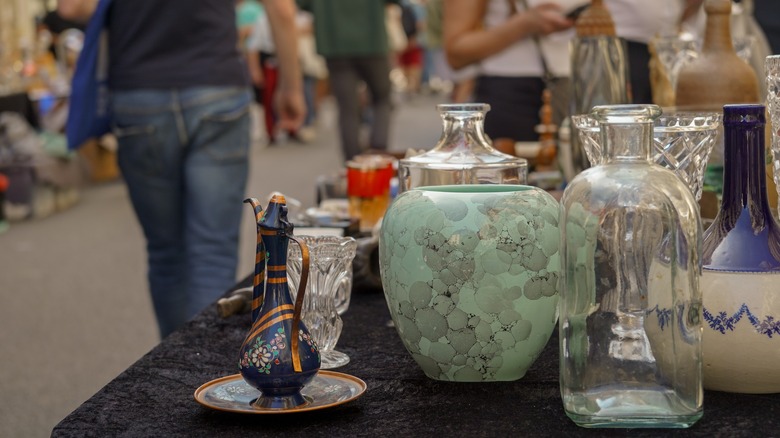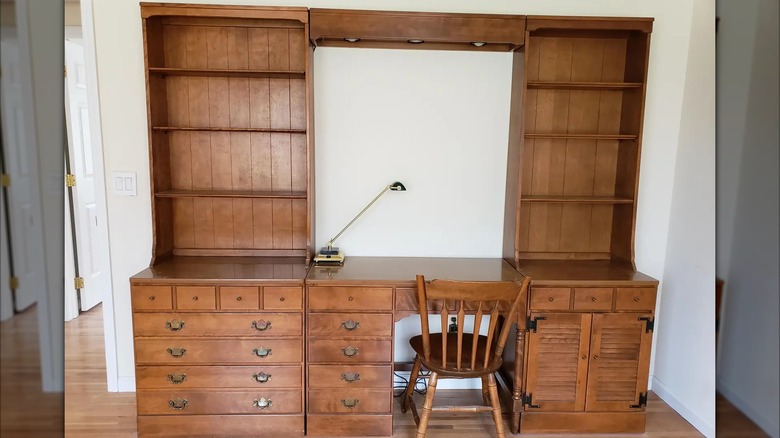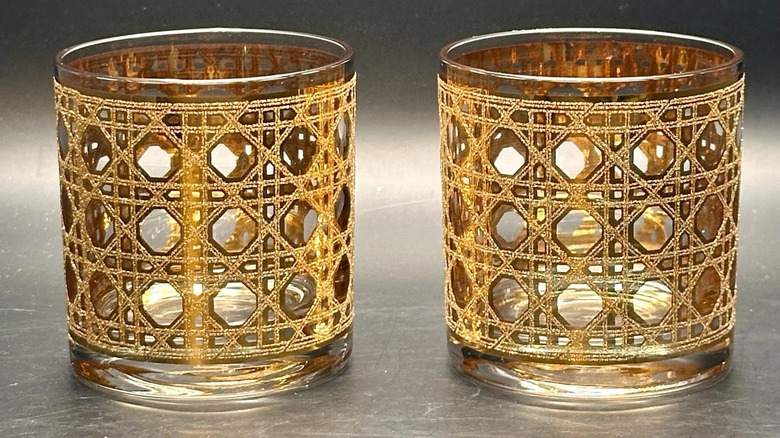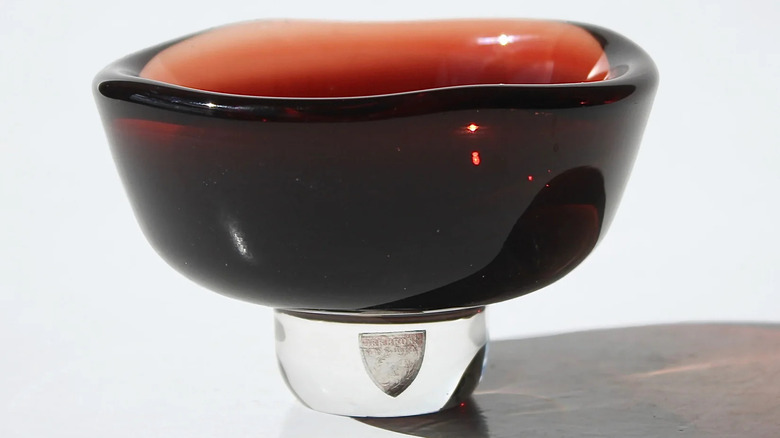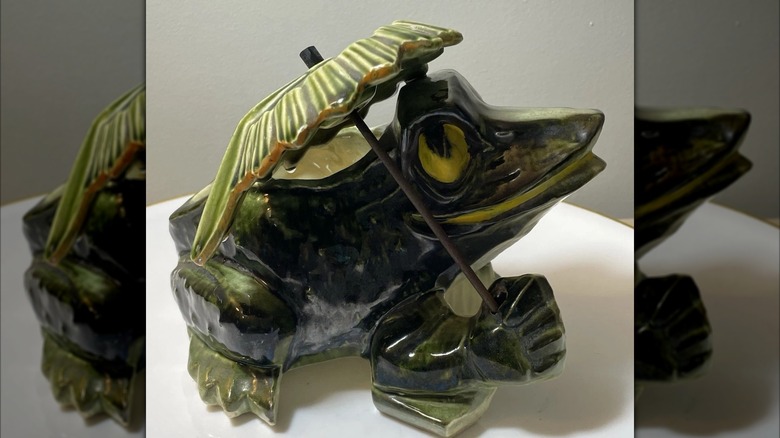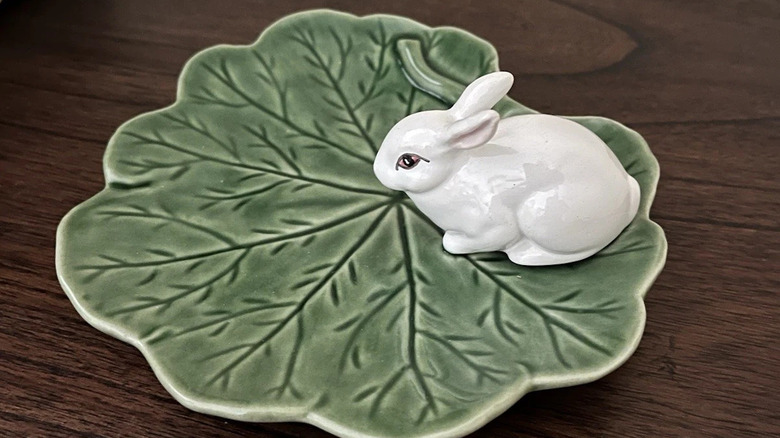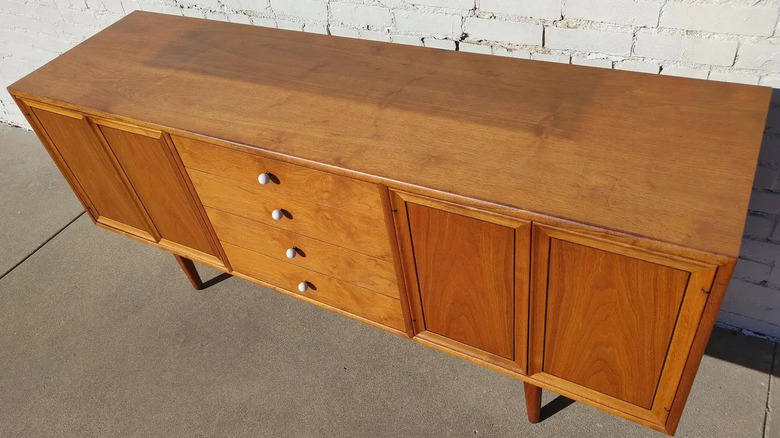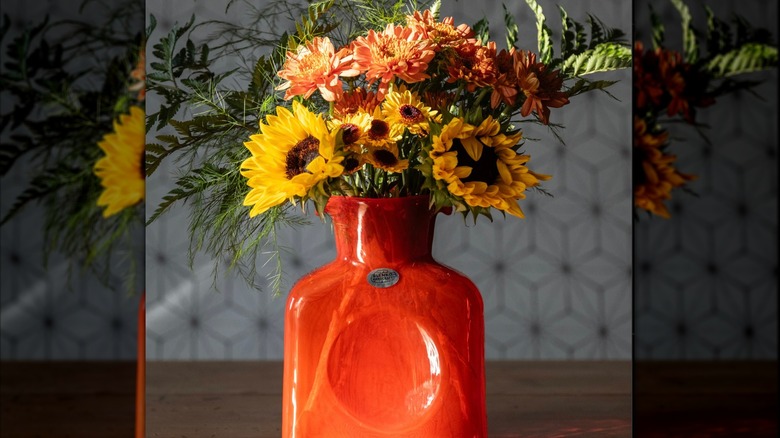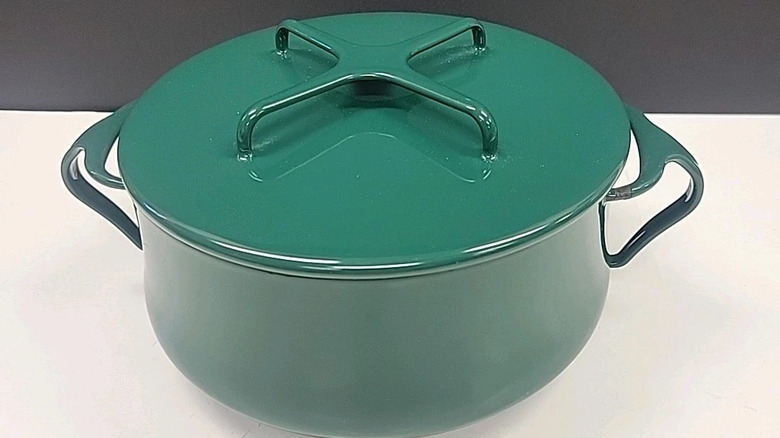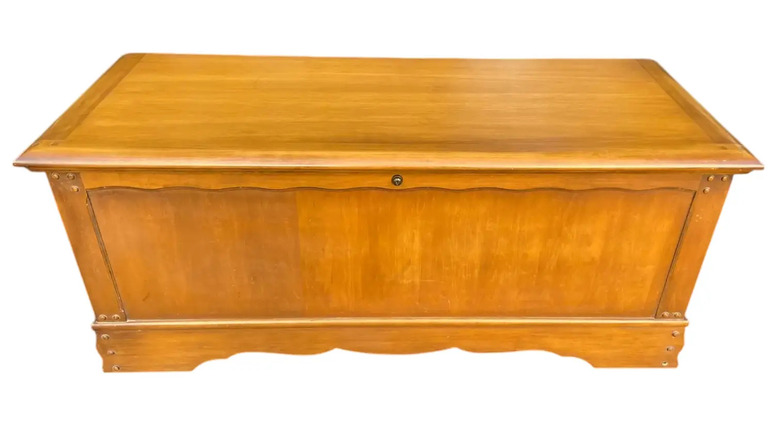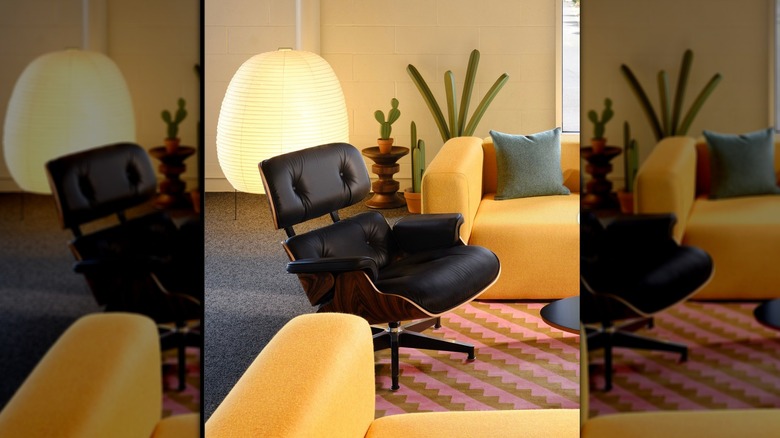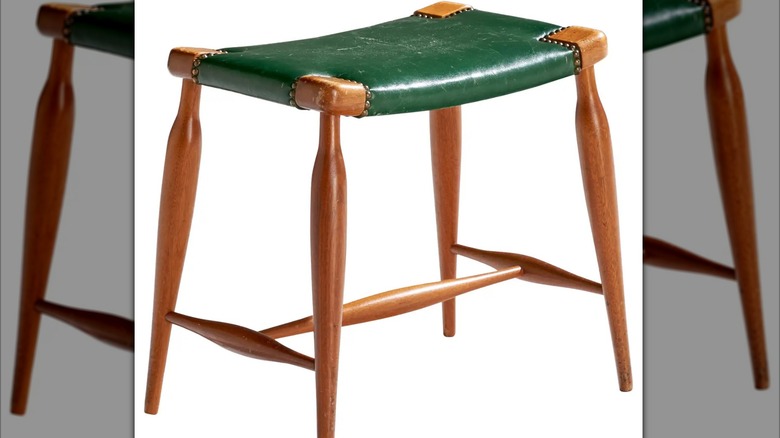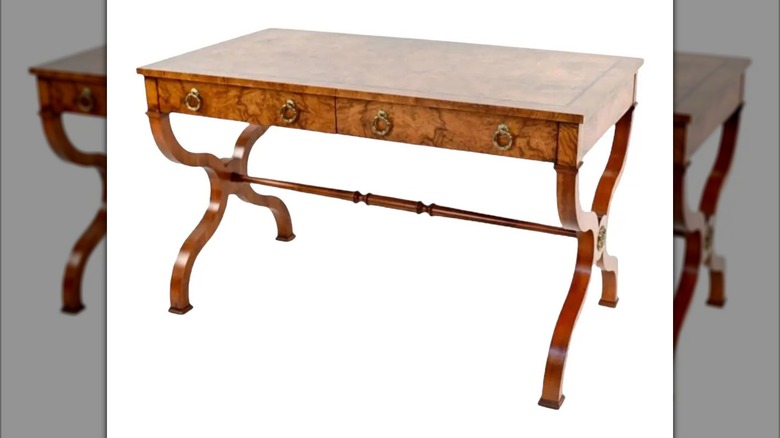12 Vintage Brands That Are Always Worth Buying At Thrift Stores
It can be difficult to know what's actually worth taking home when shopping secondhand, but these 12 vintage brands are always due some consideration if you see them in a thrift store. Whether you are using Facebook Marketplace as the ultimate furniture-shopping tool or just poking around at your local shops, some pieces are going to be a dime a dozen, but others are real hidden gems. When you're thrifting, it's easy to get overwhelmed by endless rows of mismatched furniture and piles of glassware. That's exactly why knowing the names and characteristics of these tried-and-true vintage brands can completely change the way you shop.
The makers listed here were (and some are still even in production!) known for quality craftsmanship, timeless designs, and great materials. A table, chair, or even carafe from one of these labels can often outlast most modern, mass-produced pieces. With these items in one hand, and an ultimate guide to vintage decor in the other, you are well on your way to creating a home with real character. Here's what to look for and how to know if it's the real deal or not.
Vintage Ethan Allen is solid wood gold
Ethan Allen still has modern brick-and-mortar storefronts, so you might not pay too much attention if you see it in a thrift store. However, the brand has been making furniture since 1935! There is a chance the pieces you run into secondhand are vintage. Before the 1990s, the company focused on solid wood, Colonial-inspired furniture, even presenting a solid maple chest of drawers to President Eisenhower. Modern Ethan Allen options tend to be sturdy and follow trends closely enough, these older pieces are where the real investment should be made. While 75% of all Ethan Allen furniture is still made in the United States, it is implied that through the 1950s and 60s, 100% of it was.
If you're looking for vintage Ethan Allen at a thrift store, begin by honing in on any Colonial furniture. Tell-tale signs of the style include intricate carved details on the legs and drawers, spindle-backed chairs, and maple or birch construction. These pieces also tend to look heavy or substantial, as they are solid wood. Once you spot a likely candidate, inspect for an Ethan Allen stamp, often tucked away on the underside of the piece or inside a drawer, to verify authenticity. While most pieces should have it, if it doesn't — a solid wooden piece without one still shouldn't be passed up if it's in the style you like.
Culver Canella will always seem luxurious
Like most vintage brands worth buying, Culver Canella first became popular in the United States during the mid-century. Founded in Brooklyn in 1939, the brand is the most famous for its 22-karat gold glassware which began production in the 1950s. Culver glass remains enticing to collectors to this day, in part because it has never revealed the process for attaching the gold to the glass. So, the original designs are especially valuable because they are so unique. Even if it's not your personal style, it's worth picking up for its potential resale value — which can be hundreds of dollars for just a few pieces.
Spotting Culver Canella in the wild is relatively easy if you know what to look for. In the glassware section, let your eye wander for anything gold. If it's a cocktail glass, take an even closer look! The company produced cocktail glasses adorned with gold imagery of animals and botanical shapes, plus motifs inspired by Asian and Egyptian art, which were all the rage at the time. Certain designs, like its most famous Valencia pattern, incorporated rhinestones, or green gems set into a Moroccan-style trellis that wrapped around the edge of the glass. Buying in pairs is always going to be more lucrative because it's dishware, but if you only see one, it's still worth it.
Orrefors is fine glassware that stands the test of time
Something you may not know about IKEA is that it's not the only Swedish design powerhouse to make it on a global stage. The other is Orrefors, a glassware company creating sensible, stylish pieces since the early 1900s. Originally a steel mill, the company began also creating glass jars for ink and the oh-so-Swedish lingonberry jam to make extra money. From there, it blossomed into a minimalist's glassware dream, creating things like tableware and carafes with the streamlined Scandinavian style that has never faltered in popularity, even to this day.
To make sure it's the real thing, flip the piece over and check its base. If it's authentic, it'll have the Orrefors logo, or simply the name of the brand for some older or smaller pieces, etched onto the bottom. Often, you will also see a serial number and even the designer's initials, too. Vintage items really are that personalized. Some of the work by one of the company's most famous designers, Nils Landberg, has even found its way into the collections of the National Museum in Stockholm and MoMA in New York. So, if you somehow happen to come across something with his name on it, you've really run into something special.
McCoy Pottery is now out of production, making it very valuable
While some of these vintage brands are still producing modern counterparts, McCoy Pottery is no longer in business, making coming across one of these pieces even more valuable than normal because they are so rare. Nelson McCoy found the Sanitary Stoneware Company in 1910; however, by 1933, he had updated his business model to sell mostly decorative pieces because there was higher demand — and therefore more opportunity for profit. The company eventually changed its name to the Nelson McCoy Pottery Company and is now affectionately referred to as just McCoy Pottery by those who seek it out.
These pieces can best be described as sturdy, but whimsical. Most McCoy Pottery vases, jars, or even silly little decorative frogs are going to have bright, bold colors. Lots of greens, light blues, and even butter yellows. So if you're looking for some, look for color first! Next, check the bottom of the piece to double check. It'll typically say "McCoy USA" in a thin, curly font. The "M" and the first "C," as well as the second "C" and the "O" should kind of wrap around each other. Typically, the fakes forget this part. These fun, funky pieces can add a bright spot to modern farmhouse style, with a great callback that adds a touch of nostalgia.
Bordallo Pinheiro is kitchy and fun
If you've ever spotted a cabbage-shaped bowl or a quirky piece of dinnerware that looks more like art than a plate, chances are you've come across Bordallo Pinheiro. Founded in Portugal in the late 1800s by artist Rafael Bordallo Pinheiro, the company became famous for its bold, nature-inspired ceramics. While the more modern sets can be much simpler, these vintage pieces are playful and eye-catching, adding a pop of color that treads the line between chic and kitschy perfectly. Bordallo Pinheiro pieces are also well made, with the kind of craftsmanship that makes them last for decades. If you see Bordallo Pinheiro at a thrift store, definitely grab it. Collectors and design lovers alike still pay good money for these whimsical pieces today — or they can simply add a touch of much-needed charm to your own space.
In the tableware section, much like a McCoy Pottery piece, look for color and whimsy. The brand has a knack for transforming the silliest of shapes into something quite useful. Think bright fruits, leafy vegetables, animals, and even lush greenery turned into usable tableware. Like most on this list, to verify authenticity, have a look at the bottom of the piece. Typically, there will be a mark on the bottom that's a BP monogram, an entire signature saying Raphael Bordallo Pinheiro, or even the name of where the item was made — like Caldas da Rainha, for example.
Drexel Heritage furniture is a perfect blend of old and new
Drexel furniture is still making pieces, but it has been in business since 1903 with many original works still out there. It's possible that you might find vintage offerings at a thrift store or on Facebook Marketplace. Drexel prides itself on its pieces combining the classic styles of antique European furniture with the sturdiness of American design. In fact, many of the pieces in the company's more modern collections still do look like pieces crafted half a century ago, priding itself on its timeless consistency.
Some of the collections are especially sought after by collectors and design lovers. For example, the sleek mid-century Declaration line which is made with walnut and typically in lighter finishes and often has the low-profile hallmark of the design. In addition to the highly regarded Accolade series, which adds brassy metals and marble to the look. As mid-century modern design will never go out of style, these pieces are also worth nabbing for your personal collection, too. Spotting a piece of furniture with a Drexel stamp or label on a thrift store find is usually a sign you've uncovered something special.
Blenko Glass is family-owned and handblown
This family-owned brand has more than 100 years of bright and colorful handblown glass behind it. Founded in 1893, Blenko Glass has been operating out of Milton, West Virginia since 1921. Initially, the company struggled to find its feet in America because most consumers preferred glass made in Europe. They were skeptical about the quality of anything produced in the United States. It couldn't possibly be as good. This is what sets Blenko apart from other vintage brands — it's a little piece of the history of American artistic craftsmanship that you can hold in your hand.
Vintage products include cups, carafes, bowls, and vases. They have the thin, tapered look common to handblown glass. Because each one was shaped by hand, you'll often notice tiny air bubbles, slight asymmetry, or small variations in thickness. These are all a part of the charm and proof that it isn't factory-made. Coming into the 1970s, colors like vibrant reds, cobalt blues, and sunny yellows really exploded throughout Blenko's product line, and have since become something that the brand is quite famous for today. They also make them stand out instantly on a thrift store shelf. If you're on the hunt, check for the etched mark, usually on the bottom to confirm authenticity. Sometimes there is also a sticker on pieces, but unfortunately for vintage items, it is often long gone.
Dansk has everlasting Scandinavian style
Dansk tableware and cookware is a unique blend of Scandinavian design and American spirit. In the 1950s, American Ted Nierenberg saw an exhibition by Danish designer Jens Quistgaard at the Copenhagen Museum of Art and Design. Inspired, he reached out to the artist, and together they founded a company with one aim: turning everyday kitchen items into real display pieces. The company is still producing brightly colored pots, pans, plates, and even candle holders. And, although the overall vibe of the style hasn't changed too much since its original offerings (after all, if it isn't broken you shouldn't fix it), you should always be on the lookout for its vintage offerings.
What sets vintage Dansk apart is its clean, sculptural lines and bold use of color. Many of the most collectible pieces were made from enameled steel in shades of red, yellow, and turquoise, often with wooden accents like teak handles or lids that doubled as trivets. Its dinnerware and candle holders follow the same philosophy, with simple shapes that still feel modern decades later. If you're thrifting, flip the piece over to check for the maker's mark. Older Dansk items are usually stamped with the name and country of origin, like "Dansk Designs Denmark." Cookware might have designer signatures instead, like "IHQ" (Jens Quistgaard).
Lane Furniture's early pieces were solid oak and maple
Lane Furniture got its start in 1912 in Altavista, Virginia, when John Lane turned his passion for woodworking into a small business. What began as handmade pieces crafted in his grandfather's workshop quickly gained a reputation for quality, leading to the opening of the first official location by the mid-1920s. The company's early furniture leaned traditional, built from solid oak and maple, and was designed to be both durable and affordable. As the decades passed, Lane adapted to changing tastes. It moved from the sturdy Colonial-inspired pieces into sleeker mid-century modern styles that really defined American homes of the 1950s. By the following decade, the brand was experimenting with materials like acrylic and wasn't afraid to embrace bold, forward-thinking designs.
When hunting for Lane, the most obvious starting point is its famous cedar chests, which often carry the Lane logo burned or stamped inside the lid. But mid-century coffee and end tables are equally sought after, especially those with clean lines, tapered legs, and walnut veneers that set them apart from the heavier traditional furniture of the time. Some pieces feature unique details like parquet inlays or mixed materials that show off Lane's willingness to experiment in the 1960s and 1970s. Always flip a piece over or check inside drawers for a branded mark or serial number. Lane was consistent about labeling, which makes authenticating its furniture easier than many other vintage brands.
Herman Miller Furniture has iconic, long-lasting designs
Few names carry as much weight in modern design as Herman Miller. The company has always been on the forefront of trends with sleek, forward-thinking furniture marrying form and function. In the 1940s, George Nelson joined as design director and transformed Herman Miller into a hub for some of the century's most influential creative minds! Under Nelson's leadership, legends like Charles and Ray Eames (yes, just like the famous lounge chair) Alexander Girard, and even Isamu Noguchi contributed designs that are still celebrated today.
Spotting authentic Herman Miller isn't too tricky once you know what to look for. Many pieces carry a metal or foil label on the underside, while others have the name embossed directly into the frame or base. The craftsmanship itself is also a giveaway: Clean, purposeful lines, high-quality materials like molded plywood, fiberglass, and aluminum, and an attention to ergonomics that sets them apart from lookalike knockoffs. Iconic items such as the Eames lounge chair with its curved plywood shell and leather cushions, or Noguchi's sculptural glass-topped coffee table, have been widely copied, but the originals feel solid and balanced.
Svenskt Tenn is a bright, bold, and playful touch
If your style leans more maximalist than minimalist, keep an eye out for Svenskt Tenn. Founded in 1924 by Estrid Ericson, this Swedish company first made a name for itself producing pewter objects before later expanding into furniture and textiles, too. However, the real turning point came in the 1930s, when Ericson began collaborating with Austrian architect Josef Frank. Together they created the colorful, whimsical patterns that remain Svenskt Tenn's signature today. Unlike many Scandinavian brands known for muted palettes and simple lines, Svenskt Tenn embraced bold florals, geometric shapes, and playful prints in deeply saturated colors. Its pieces feel fresh, even decades later, which is why vintage Svenskt Tenn remains highly collectible.
The thing about finding Svenskt Tenn out in the wild is that it tends to be very, very expensive. So finding it in a thrift store would kind of be like finding the holy grail. However, it could happen as family members clearing out a deceased relative's estate might not know the value, for example. Yet the pictured mahogany stool with green leather and brass accents is listed for nearly $6,000 to give you an idea of how things tend to pan out.
Baker Furniture has always been at the forefront of trends
Baker Furniture had always been a forerunner of bold new designs in the American marketplace. In 1925, the brand introduced its "Twentieth Century Shop," which kind of functioned as an ultimate guide to art deco decor. It also launched the Manor House collection in 1932, which was the very first furniture reproduction program. The collection drew heavily from traditional English and European furnishings, with many pieces modeled after antiques found in grand estates and country houses. For thrifters, spotting Baker in a secondhand shop is like striking gold. These pieces were built with top-quality materials and exceptional attention to detail, meaning they not only survive decades of use but often gain character with age.
Identifying Baker Furniture usually comes down to the mix of craftsmanship and subtle detailing. Many pieces carry a brass or paper label inside drawers or on the back, but even without a tag, the quality is hard to miss. The wood is typically solid and finished to a high polish, with smooth drawer glides and dovetail joints that speak to its construction. So, when you come across a piece that feels sturdier, heavier, and more thoughtfully designed than its neighbors in the shop, it is worth taking a closer look to see if Baker's name is attached.
